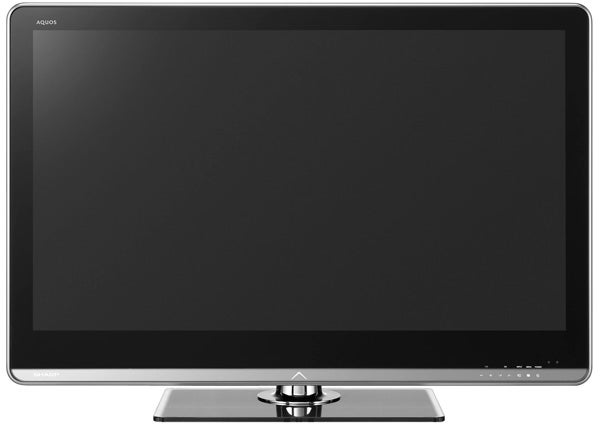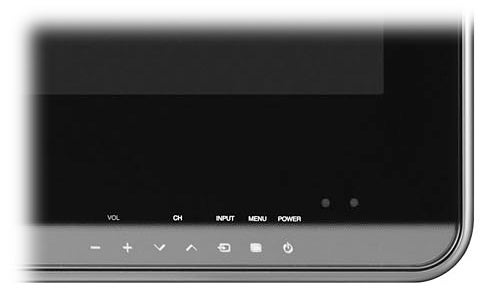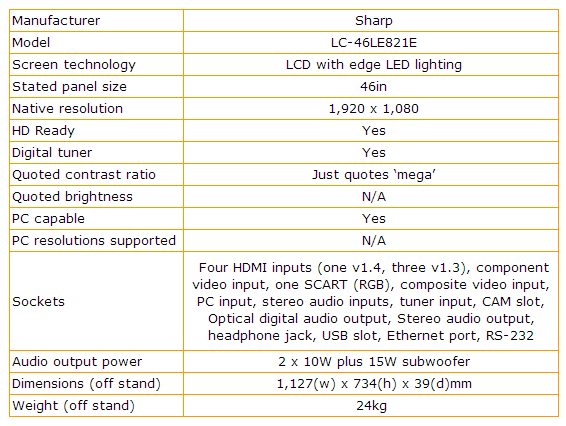Sharp Aquos LC-46LE821E 46in LED-Lit LCD TV Review
Sharp Aquos LC-46LE821E 46in LED-Lit LCD TV
Sharp mixes in a yellow sub-pixel to the usual red, green and blue ones with great effect.

Verdict
Key Specifications
- Review Price: £1649.95
The TV feature of the moment, without a shadow of doubt, is 3D. The hype surrounding this intriguing new TV development seemingly knows no bounds. Which is a damn shame for Sharp’s LC-46LE821E.
For rather than jumping on the 3D bandwagon, the 46in 46LE821E is ploughing its own innovation furrow with a little trick called Quad Pixel technology. A trick that’s tragically likely to get completely lost amid the whole 3D marketing maelstrom, despite the fact that it’s really rather good.
As you can doubtless tell from its name, Quad Pixel technology has something to do with the number four. And that ‘something’ is the addition of a yellow sub-pixel to the normal red, green and blue ones usually found in LCD TVs.
At first, this perhaps doesn’t sound all that significant compared with adding a whole extra depth dimension to images as offered by 3D. But anyone who’s had more than a passing interest in TVs will know that throughout the history of colour television, the thinking has always revolved around the core red, green and blue triumvirate. So for Sharp to suddenly expand this fundamental aspect of colour TV construction really is a big deal. 
Of course, if adding a fourth colour sub-pixel to proceedings is really that important, you might well wonder why nobody else has done it before. But the answers to this are simply that a) making four sub-pixels happen requires the sort of out-of-the-box thinking that’s not always a feature of the AV world at large, and b) adding a fourth sub-pixel is actually pretty difficult.
After all, the 46LE821E only has the same screen ‘real estate’ to deal with as any ordinary 46in LCD TV. So Sharp has had to completely redesign its LCD pixel structure to make room for the yellow sub-pixel alongside its red, green and blue brethren. This process, Sharp claims, has taken no less than four years of R&D to perfect.
Needless to say, Sharp hasn’t just undertaken such an extensive development process for fun. Adding the yellow sub-pixel to proceedings promises to deliver some truly significant picture quality improvements.
The most obvious of these is an improved colour palette. Yellows, naturally, should be able to look much purer and more natural since there’s no longer a need for yellow colours to be ‘mixed’ from the red, green and blue pixels. But actually the impact goes much further than this, with yellow derivatives like gold and mustard also potentially looking much more accurate than they can on normal LCD TVs.
In fact, almost all colours have the potential to benefit from the yellow sub-pixel, since the more core colours a TV has at its disposal for creating hues across the spectrum, the more accurate those colours could be. Cue the charming claim by Sharp that its Quad Pixel TVs can produce 1,000 times more colour than any ordinary RGB model!
There’s a good reason why Sharp has chosen to add yellow rather than cyan or magenta to the RGB mix, too. For yellow is the most ‘transparent’ of the secondary trio of colours, allowing light to pass through more easily and so helping the 46LE821E potentially look brighter (20 per cent brighter, according to Sharp) than normal LCD TVs.
The relative translucency of the yellow sub-pixel should also help the 46LE821E run more efficiently, as it doesn’t have to push as much light out from its edge LED lighting array.
Yes, we did say edge LED lighting back there. For as well as being Sharp’s debut Quad Pixel TV, the 46LE821E is also the first TV we’ve seen from the brand that uses edge rather than direct LED backlighting.
As we would hope, this has enabled Sharp to radically improve its design credentials compared with last year’s chunky direct LED 600E and 700E models. The 46LE821E sports a slender (39mm), sleek and polished design, given added panache courtesy of a glass-like external trim, and an angled sliver of metal along the bottom edge containing an attractive illuminated Sharp ‘triangle’ logo.
We’re not done with the 46LE821E’s pioneering spirit yet, either. For it also sports 8GB of built-in memory for recording programmes – losslessly – from its built-in digital tuners. Cool. These digital tuners include the latest Freeview HD system, too, with the 8GB memory able to store up to two and a half hours of standard definition content or around 50 minutes of high definition material.
The 46LE821E’s already strong shelf appeal merely grows as we check out its connections. For alongside an eminently respectable collection of four HDMIs, you can find an RS-232 control/system integration socket, a USB port for playing both JPEG stills and DivX video files (including HD ones), and even an Ethernet port.
This is the first time we’ve seen an Ethernet port on a Sharp TV – and frankly, it’s long overdue in this multimedia age. But before we get too carried away, it turns out that the Ethernet port is not capable of accessing any online Sharp services along the lines of Sony’s Bravia Internet Video or Samsung’s Internet@TV platform. What it ”can” do, however, is both handle potential future Freeview HD interactive features and access stuff stored on a DLNA-ready PC. 
Turning to the 46LE821E’s onscreen menus, even here Sharp has decided to do things differently – to great effect. The first thing that happens when you call up the onscreen menus is that the whole picture shrinks a bit, so that a double-axis menus style can wrap itself around the picture’s edges without, excellently, sitting over it. So you can continue to watch an unsullied picture while you explore what the menus have to offer. This idea works so well we can’t believe nobody has done it before.
The 46LE821E has a decent selection of picture fine-tuning features, with highlights spotted during our calibration efforts including a solid colour management tool, a Fine Motion setting for reducing judder, decent colour temperature flexibility, and plenty of gamma adjustments.
It’s a pity, perhaps, that the 46LE821E forces even TV novices to explore at least some of its more involved fine-tuning tools on account of its picture presets being pretty ill-judged. But this is hardly unusual in the LCD TV world.
And so we get to the moment of truth: does the yellow sub-pixel really profoundly improve the 46LE821E’s picture quality? Actually, you know, it kind of does…
As we’re feeling in a rather perverse mood, today, though, we’re going to start with the bad news about the TV’s pictures. Which is that its black level response could be better. 
There’s a touch of thankfully low-level backlight inconsistency around (which increases considerably if you have to watch from much of an angle), but also black colours generally tend to look a touch grey. An effect that possibly ironically owes something to the way the yellow sub-pixel transmits the backlighting more easily than normal LCD panels.
However, let’s quickly set about justifying the 9 out of 10 score for picture quality we’ve awarded this TV by saying that there’s a big chunk of compensation for the slightly grey black levels in the form of much more shadow detail during dark scenes than we’re accustomed to seeing with LCD TVs – LED-lit or otherwise.
During dark shots like, say, the night-time images outside Bond’s hotel in the Bahamas in ”Casino Royale”, you can see all sorts of sundry low-level details in the darkest corners that just don’t come out on normal LCD TVs. This helps dark scenes look markedly more immersive, natural and three-dimensional – erm, in a non-3D kind of way! – than those of almost any other LCD TV we can think of right now.
Then, of course, there’s the 46LE821E’s colour response. Which really is a sight to behold. There are two different but equally important reasons for this. First, colours look fantastically vibrant and dynamic thanks to the image’s exceptional brightness – another asset of the extra translucency of each LCD pixel created by the addition of the yellow sub-pixel. And second, the spectrum of the colours the screen can show is much more expansive than we’re used to seeing on LCD and plasma TVs.
Not surprisingly it’s yellow- and gold-based colours that benefit most obviously from the quad pixel system. But colours right across the board tend to look more believable, subtle and expressive.
When we first started using the TV, we occasionally felt that some pictures actually started to look a touch too yellow. But some judicious play with the colour management tools reduced this issue – and in any case, we found ourselves ‘acclimatising’ to the effect over time. In fact, we grew to suspect that actually the 46LE821E was showing pictures correctly, and it was merely our lack of experience of seeing yellow introduced to pictures so purely that made them look initially slightly off-key.
Given the motion blur problems we found with Sharp’s LE600E and LE700E direct LED TVs, it’s a relief to report that the 46LE821E handles motion rather well, with minimal blur or judder. There’s a small price to pay for this extra clarity in the form of some gentle motion artefacts – mostly the familiar distortion haloes around moving objects. But if you’re careful with the TV’s settings, you shouldn’t find yourself distracted by these side-effects too often.
The lack of motion blur allows us to fully embrace the screen’s excellent crispness and level of detail when showing HD pictures, too. And finally, Sharp has really upped its standard definition upscaling game for its ground-breaking new TV, finally managing to make standard def sources look reasonably sharp and clean rather than soft and noisy.
Sharp has upped its audio game for the 46LE821E, too. There’s much more raw power at the disposal of its speakers than we found with last year’s Sharp models, which helps the soundstage appear crisper, more expansive, more dynamic and generally more immersive. A bit more bass depth would have sealed the audio deal, but we’d say it’s a perfectly adequate accompaniment to the outstanding pictures.
”’Verdict”’
If Quad Pixel technology had been developed by the likes of Sony, Samsung or Panasonic, you can bet your bottom dollar they’d be screaming about it at the top of their marketing lungs from the top of the nearest mountain. Sadly, Sharp doesn’t seem to currently lavish anywhere near as much promotional muscle on its new technology as it deserves.
But do yourself a favour. If you don’t have a problem with spending £1,650 on a TV these days that doesn’t have 3D technology, book yourself an audition with the 46LE821E. You won’t be disappointed.
All that remains is to wonder how long it’s going to take Sharp to squeeze cyan and magenta sub-pixels in there too!

How we test televisions
We test every TV we review thoroughly over an extended period of time. We use industry standard tests to compare features properly. We’ll always tell you what we find. We never, ever, accept money to review a product.
Trusted Score
Score in detail
-
Features 8
-
Value 7
-
Image Quality 9
-
Design 9
-
Sound Quality 8
Features
| Size (Inch) | 46in |
| Display Type | LED |
| Max. Resolution | 1920 x 1080 |
| Digital Tuner | DVB-S2 |
| Refresh Rate (Hertz) | 100Hz |
Physical Specifications
| Height (Millimeter) | 59.6mm |
| Width (Millimeter) | 1127mm, 103mm |
| Weight (Gram) | 30g |

